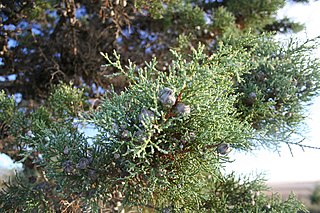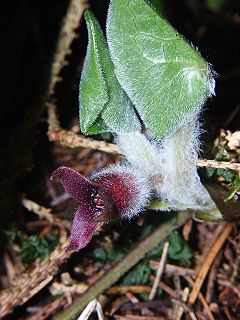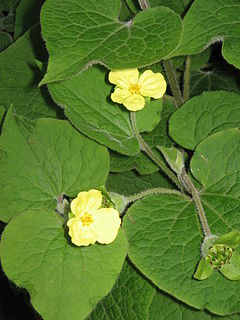
The Aristolochiaceae are a family, the birthwort family, of flowering plants with seven genera and about 400 known species belonging to the order Piperales. The type genus is Aristolochia L.

Cypress is a common name for various coniferous trees or shrubs of northern temperate regions that belong to the family Cupressaceae. The word cypress is derived from Old French cipres, which was imported from Latin cypressus, the latinisation of the Greek κυπάρισσος (kyparissos).

Asarum is a genus of plants in the birthwort family Aristolochiaceae, commonly known as wild ginger.

Asarum europaeum, commonly known as asarabacca, European wild ginger, hazelwort, and wild spikenard, is a species of flowering plant in the birthwort family Aristolochiaceae, native to large parts of temperate Europe, and also cultivated in gardens. It is a creeping evergreen perennial with glossy green, kidney shaped leaves and solitary dull purple flowers hidden by the leaves. Though its roots have a ginger aroma, it is not closely related to the true culinary ginger Zingiber officinale, which originates in tropical Asian rainforests. It is sometimes harvested for use as a spice or a flavoring. In former days, it was used in snuff and also medicinally as an emetic and cathartic.

Ulmus castaneifoliaHemsley, the chestnut-leafed elm or multinerved elm, is a small deciduous tree found across much of China in broadleaved forests at elevations of 500–1,600 metres (1,600–5,200 ft).

Ulmus szechuanicaFang, known as the Szechuan (Sichuan), or red-fruited, elm, is a small to medium deciduous Chinese tree found along the Yangtze river through the provinces of Sichuan, Jiangxi, Anhui, and Jiangsu.

Asarum splendens, the Chinese wild ginger or showy Sichuan ginger, is a species of wild ginger.

Asarum canadense, commonly known as Canada wild ginger, Canadian snakeroot, and broad-leaved asarabacca, is a herbaceous, perennial plant which forms dense colonies in the understory of deciduous forest throughout its native range in eastern North America, from the Great Plains east to the Atlantic Coast, and from southeastern Canada south to around the Fall Line in the southeastern United States.

Asarum caudatum is native to rich moist forests of western North America from British Columbia to California and as far east as western Montana. It is an evergreen with flowers that develop from March to August. The flowers are distinct, hirsute (hairy), cup-shaped, and brown-purple to green-yellow which terminate in three, long, gracefully curved lobes, often concealed by leaves. The long rhizomes give rise to persistent reniform leaves. Leaves are found in colonies or clusters as the rhizome spreads, forming mats. The leaves emit a ginger aroma when rubbed.

Luehdorfia chinensis, the Chinese luehdorfia, is a species of butterfly in the family Papilionidae. It is endemic to China.

The Japanese luehdorfia is a species of butterfly in the subfamily Parnassiinae of Papilionidae. It is found only in Japan. It was discovered by Yasushi Nawa in Japan's Gifu Prefecture in 1883. It is also known as the Gifu butterfly

Asarum maximum is a species of plant in the family Aristolochiaceae. It is endemic to China. The flowers have a distinct smell of mushrooms.

Helicia is a genus of 110 species of trees and shrubs, constituting part of the plant family Proteaceae. They grow naturally in rainforests throughout tropical South and Southeast Asia, including India, Sri Lanka, Indochina, Peninsular Malaysia to New Guinea and as far south as New South Wales.
Disepalum plagioneurum is a species of plant in the Annonaceae family. It is found in China and northern Viet Nam.

Saruma is a monotypic genus of flowering plants in the family Aristolochiaceae containing the single species Saruma henryi. It is endemic to China, where it occurs in Gansu, Guizhou, Hubei, Jiangxi, Shaanxi, and Sichuan.
Aleuritopteris albofusca is a species of fern in the family Pteridaceae. It is endemic to China, including Tibet. Its natural habitat is subtropical or tropical dry forests. It is threatened by habitat loss.

Spikenard, also called nard, nardin, and muskroot, is a class of aromatic amber-colored essential oil derived from Nardostachys jatamansi, a flowering plant in the honeysuckle family which grows in the Himalayas of Nepal, China, and India. The oil has been used over centuries as a perfume, a traditional medicine, or in religious ceremonies across a wide territory from India to Europe. Historically, the name nard has also referred to essential oils derived from other species including the closely related valerian genus, as well as Spanish lavender; these cheaper, more common plants have been used in perfume-making, and sometimes to adulterate true spikenard.

Cytinus hypocistis is an ant-pollinated species of parasitic plant in the family Cytinaceae having four subspecies. It is found primarily in locations that surround the Mediterranean Sea, and is the type for the genus Cytinus. The binomial has been conserved.
Asarum rosei is a species of flowering plant endemic to North Carolina in the southeastern United States. It was first formally described in 2017 by Brandon T. Sinn in Phytotaxa. The species is named for Mark Rose, "a respected plant collector, horticulturalist, orchid breeder, and naturalist who discovered and documented the species".

Asarum monodoriflorum, also known by the common name Monodora-kan-aoi, is a low-growing, herbaceous perennial plant. It is critically endangered.

















